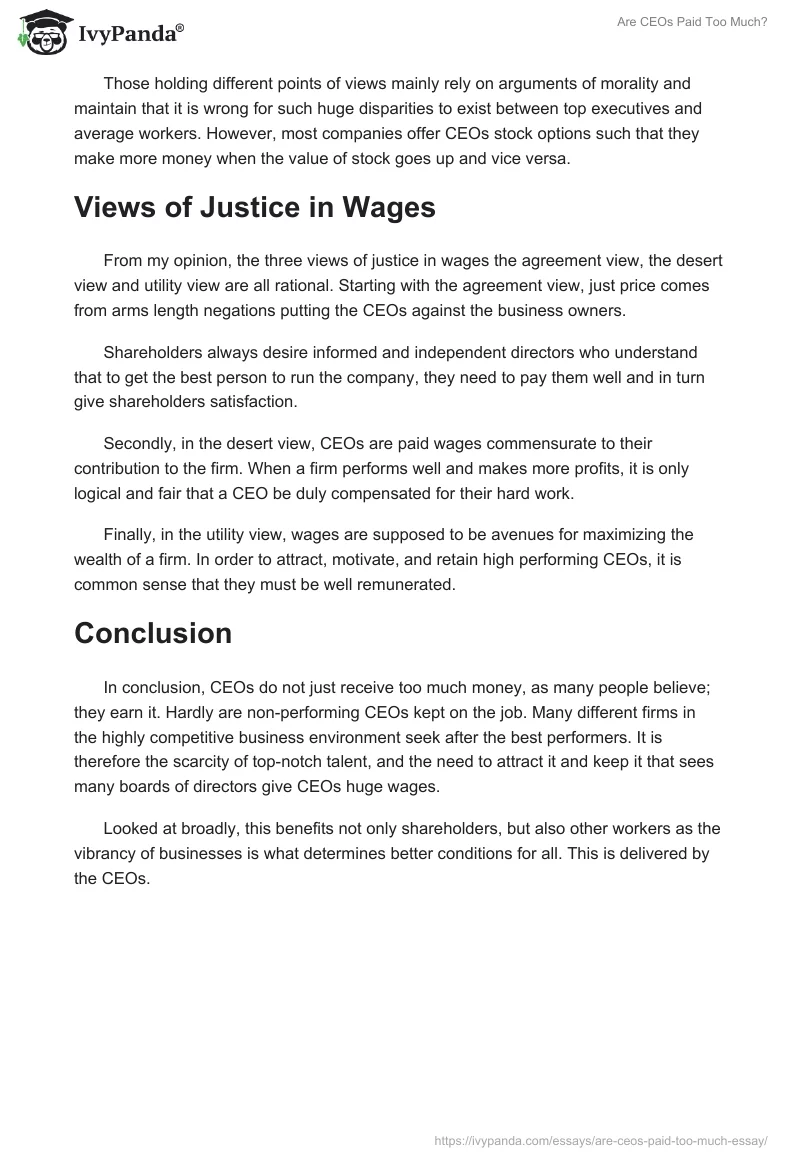Introduction
Business ethics look at the moral values and the problems that are associated with businesses. It relates to all business spheres and is significant to both organizations and persons. Fundamentally, dealing with morality issues, business ethics also include financial matters stretching to just how much employees should be paid. Corporate executives around the world and especially in America are paid hefty amounts of money.
Some of the largest corporations pay their CEOs 300 times more than the wage of their average worker. This begs the question; do they rightly deserve what they earn? Is it justified or not? A debate has been raging over this question with the two sides of yes and no giving their reasons. When many average workers compare their remuneration to what their CEOs get, they feel underpaid.
This makes them the majority among those opposing high pays for CEOs. On the other hand, business owners understand the importance of having the best person to run their businesses and make more money for them thus; they pay the CEOs hefty salaries. Clearly, this question requires objectivity and clear reasoning in answering it.
Justification for Huge Salaries
Business is about making money and in today’s highly competitive business world, it requires highly skilled business leaders that can navigate competition and strategically position a company to make profits. Without this, it is hard to survive the tough times and bring growth. All round the world, there are executives that have proven themselves and they are highly sought after to run businesses.
Therefore, it is expected that business owners will do anything to get hold of these leaders and hold on to them. It is clearly a classic case of demand and supply that even people with the least knowledge of economics understand. Most CEOs that are paid a lot of money often deliver on their work.
Those holding different points of views mainly rely on arguments of morality and maintain that it is wrong for such huge disparities to exist between top executives and average workers. However, most companies offer CEOs stock options such that they make more money when the value of stock goes up and vice versa.
Views of Justice in Wages
From my opinion, the three views of justice in wages the agreement view, the desert view and utility view are all rational. Starting with the agreement view, just price comes from arms length negations putting the CEOs against the business owners.
Shareholders always desire informed and independent directors who understand that to get the best person to run the company, they need to pay them well and in turn give shareholders satisfaction.
Secondly, in the desert view, CEOs are paid wages commensurate to their contribution to the firm. When a firm performs well and makes more profits, it is only logical and fair that a CEO be duly compensated for their hard work.
Finally, in the utility view, wages are supposed to be avenues for maximizing the wealth of a firm. In order to attract, motivate, and retain high performing CEOs, it is common sense that they must be well remunerated.
Conclusion
In conclusion, CEOs do not just receive too much money, as many people believe; they earn it. Hardly are non-performing CEOs kept on the job. Many different firms in the highly competitive business environment seek after the best performers. It is therefore the scarcity of top-notch talent, and the need to attract it and keep it that sees many boards of directors give CEOs huge wages.
Looked at broadly, this benefits not only shareholders, but also other workers as the vibrancy of businesses is what determines better conditions for all. This is delivered by the CEOs.


